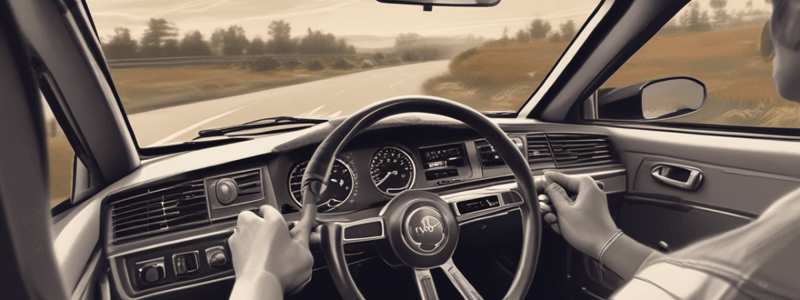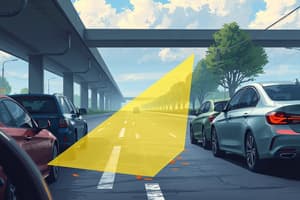Podcast
Questions and Answers
What should you do if you start to skid?
What should you do if you start to skid?
- Take your foot off the accelerator and turn the steering wheel sharply to the left.
- Press the brake pedal firmly and turn the steering wheel in the opposite direction of the skid.
- Accelerate quickly to regain traction.
- Slowly remove your foot from the accelerator and turn the steering wheel in the direction of the skid. (correct)
Why might your vehicle skid, regardless of which way the steering wheel is turned?
Why might your vehicle skid, regardless of which way the steering wheel is turned?
- If you're driving on a slippery surface.
- If you brake too hard when you're going too fast. (correct)
- If you're driving uphill.
- If you're driving too slowly.
What should you do if your vehicle is equipped with rear-wheel ABS and begins to skid?
What should you do if your vehicle is equipped with rear-wheel ABS and begins to skid?
- Take your foot off the accelerator and coast to a stop.
- Ease up on the brake pedal while maintaining just enough pressure to allow the front wheels to roll again. (correct)
- Press the brake pedal firmly and turn the steering wheel sharply.
- Remove your foot from the brake pedal and turn the steering wheel in the opposite direction.
How can you avoid skidding on slippery surfaces?
How can you avoid skidding on slippery surfaces?
What should you do if your vehicle is not equipped with ABS and begins to skid?
What should you do if your vehicle is not equipped with ABS and begins to skid?
What is the recommended starting position for Hand-to-Hand Steering?
What is the recommended starting position for Hand-to-Hand Steering?
When parking on a hill, what should you do to prevent your vehicle from rolling?
When parking on a hill, what should you do to prevent your vehicle from rolling?
When would you use the Hand-Over-Hand Steering method?
When would you use the Hand-Over-Hand Steering method?
Where should you place your hand when one-hand steering is required while backing up?
Where should you place your hand when one-hand steering is required while backing up?
When backing up, what should you do to maintain control of the vehicle?
When backing up, what should you do to maintain control of the vehicle?
Why would you use hand-and-arm signals?
Why would you use hand-and-arm signals?
What should you do when heading downhill and parking on a hill?
What should you do when heading downhill and parking on a hill?
When should you signal?
When should you signal?
When parking on a sloping driveway, what should you do with the wheels?
When parking on a sloping driveway, what should you do with the wheels?
What is the purpose of turning the wheels when parking on a hill?
What is the purpose of turning the wheels when parking on a hill?
What is permitted during the drive test?
What is permitted during the drive test?
What is the purpose of the drive test?
What is the purpose of the drive test?
What happens if your vehicle does not meet the requirements?
What happens if your vehicle does not meet the requirements?
What is prohibited during the drive test?
What is prohibited during the drive test?
What exceptions are made for accompanying you during the drive test?
What exceptions are made for accompanying you during the drive test?
Flashcards
Safe Backing
Safe Backing
Back up in a straight line, within three feet of the curb, continually checking for obstacles.
Hill Parking
Hill Parking
Park on a hill with the steering wheel angled into the curb (or away from it, depending on the slope).
Colored Curbs
Colored Curbs
Painted colored curbs have specific parking rules.
Skid Prevention
Skid Prevention
Signup and view all the flashcards
Skid Recovery
Skid Recovery
Signup and view all the flashcards
ABS Braking
ABS Braking
Signup and view all the flashcards
Non-ABS Braking
Non-ABS Braking
Signup and view all the flashcards
Hand-to-Hand Steering
Hand-to-Hand Steering
Signup and view all the flashcards
Hand-Over-Hand Steering
Hand-Over-Hand Steering
Signup and view all the flashcards
One-Hand Steering
One-Hand Steering
Signup and view all the flashcards
Signal Usage
Signal Usage
Signup and view all the flashcards
Behind-the-Wheel Test
Behind-the-Wheel Test
Signup and view all the flashcards
Vehicle Safety Tech
Vehicle Safety Tech
Signup and view all the flashcards
Parking Brake
Parking Brake
Signup and view all the flashcards
Low Traction
Low Traction
Signup and view all the flashcards
Vehicle in Park
Vehicle in Park
Signup and view all the flashcards
Vehicle in Gear
Vehicle in Gear
Signup and view all the flashcards
Three Vehicle Lengths
Three Vehicle Lengths
Signup and view all the flashcards
Intersections & Curves
Intersections & Curves
Signup and view all the flashcards
Gear Shifting
Gear Shifting
Signup and view all the flashcards
Study Notes
Backing Up Safely
- Look in your rearview mirror and over your shoulder for approaching vehicles and pedestrians.
- Back up in a straight line for three vehicle lengths while remaining within three feet of the curb.
Parking on a Hill
- Set the parking brake and leave the vehicle in park, or in gear for manual transmission.
- Turn the wheels:
- On a sloping driveway: into the curb.
- Headed downhill: into the curb or towards the side of the road.
- Headed uphill: away from the curb and let the vehicle roll back a few inches.
- No curb: towards the shoulder of the road.
Parking at Colored Curbs
- Painted colored curbs have special parking rules.
Preventing Skidding
- Slow down at intersections and curves.
- Avoid fast turns and quick stops.
- Shift to low gear before going down a steep hill.
- Avoid areas with low traction.
Recovering from a Skid
- Slowly remove your foot from the accelerator.
- Do not use the brakes.
- Turn the steering wheel in the direction of the skid.
Locked Wheel Skids
- If equipped with ABS, apply firm pressure on the brake pedal.
- If not equipped with ABS, pump the brakes until at a safe speed.
Steering Techniques
Hand-to-Hand Steering
- Start with hands at 9 and 3 o'clock or 8 and 4 o'clock.
- Do not cross hands over the middle of the steering wheel.
Hand-Over-Hand Steering
- Start with hands at 8 and 4 o'clock.
- Reach across the steering wheel to grasp the opposite side.
- Let go with one hand and reach across with the other.
One-Hand Steering
- Use when turning while backing up or operating vehicle controls.
Signals, Horns, and Headlights
- Always signal when turning, changing lanes, slowing down, or stopping.
- Use signal lights or hand-and-arm positions.
Behind-the-Wheel Test
- The test evaluates your skill in operating a motor vehicle.
- Advanced driver assistance systems are not permitted during the test.
- Vehicle safety technology may be used, but not as a replacement for actual visual checks.
Studying That Suits You
Use AI to generate personalized quizzes and flashcards to suit your learning preferences.


